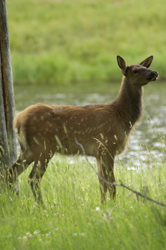Elk
Updated: August 12, 2020

Montana's most popular big game animal is the Rocky Mountain Elk, or "Wapiti," a Shawnee Indian word which means "white rump." Their scientific name is Cervus elaphus. Elk are members of the deer family. Other members include moose, caribou, white-tailed and mule deer.
Elk live in groups or herds that consist of cows, calves, and yearlings while the bulls gather in bachelor groups or alone. Harems are formed with one or two mature bulls during the rutting (mating) season. One of the advantages of being a herd animal is that it provides a good defense against predators, as there are many eyes, ears, and noses to detect threats. Elk have keen senses that enable them to identify each other over long distances and to detect approaching predators such as wolves, mountain lions, and grizzly bears. Their eyes can detect movement of even the slightest shifting of grass. Because their big eyes are on the sides of the head, elk can see what is happening ahead of them and beside them, as well as most of what is going on behind them.
Male elk, called bulls, have antlers that can weigh up to forty pounds. They shed and grow back their antlers every year. A mature bull elk can grow a set of six-point antlers in approximately 140 days. That's about an inch a day! As fall approaches they start rubbing trees to remove the fuzzy skin called velvet from their antlers. This exposes the antler, which is now hard bone. The antlers drop off completely, but the next set is already starting to grow. Antlers contain the fastest growing tissue known to science.

Fall is the breeding season. Bull elk become aggressive and bugle loudly to challenge other male elk. They spar with their antlers, which usually turns into pushing matches to determine which elk is stronger. Cow elk then choose the strongest bulls as mates. A mature bull elk can reach a weight of 1,000 pounds, but they generally average about 700 pounds. This makes for interesting shoving matches. Many people visiting Yellowstone National Park in September and early October can observe these elk battles.
Female elk, called cows, usually give birth to one calf each year in the spring when they are about two and a half years of age. Though cows usually only have one calf, twins aren't uncommon. Female elk have been known to occasionally live in the wild to an old age of over 20 years
A baby elk is called a calf. The first couple of weeks in the life of a calf are critical to its survival. Calves are about 14 pounds at birth. The cow protects the calf by hiding and watching over it from a safe distance, only visiting to allow the calf to nurse. This behavior helps prevent the leading of predators directly to the calf. They have very little scent and their hide is covered with white spots for camouflage. After a couple of weeks, the calves grow strong enough to keep up with their mothers. Once mother and calf are mobile, they join other cows and calves in large herds. They remain in these large herds during the summer months, separate from the bulls that are in groups of their own.
Elk live chiefly in high, open mountain pastures during the summer and in lower wooded slopes or dense woods during the winter. Winter is the toughest time for wildlife in Montana. Snow comes early to the high mountains pushing elk down to lower elevations. Land in most of these lower elevations is in towns, cities, farms, and ranches and along roads and highways. Elk obviously have difficulty wintering in cities and around highways. Many elk winter on agricultural lands and during a hard winter elk and livestock compete for food.
Elk are herbivores and primarily grazers. They eat a lot of forbs such as dandelions in the summer. In the winter months especially when grasses are covered by snow the elk will dig down to the grass or feed on the twigs and bark of woody plants above the snow. You can often tell if elk winter in an area by the scars left on the trunks of aspen trees.
Despite reintroduction efforts, elk will probably never return to their historic numbers. Some biologists point out that more elk populate North America now than at any time in the last 100 years. But even with this increase in numbers, far fewer elk live in North America today than did 200 years ago. They simply can't compete with humans, and humans are unlikely to give up land thatís already been settled or to stop encroaching upon the habitat that remains.
Updated: August 12, 2020



